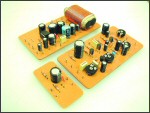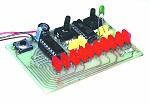


![]() Pain Monitor — designed in response to a request from a consultant anaesthetist, this device is a patient welfare logger that enables a record to be kept of pains experienced by a patient. A row of 10 pushbutton switches represent and record pain threshold values. Two more buttons record the presence (or absence) of other symptoms, e.g nausea or itch. Serial interface to a Windows PC, and the resulting data can be analysed in Microsoft Excel. Provision for monitoring up to 99 patients on the same unit. An LCD displays latest recorded patient data. Battery powered, with memory backup.
Pain Monitor — designed in response to a request from a consultant anaesthetist, this device is a patient welfare logger that enables a record to be kept of pains experienced by a patient. A row of 10 pushbutton switches represent and record pain threshold values. Two more buttons record the presence (or absence) of other symptoms, e.g nausea or itch. Serial interface to a Windows PC, and the resulting data can be analysed in Microsoft Excel. Provision for monitoring up to 99 patients on the same unit. An LCD displays latest recorded patient data. Battery powered, with memory backup.
![]()

![]() Back To Basics Kitchen Timer - using simple 4000 CMOS devices, we demonstrate how to build some basic but useful circuits that are ideal for beginners. A kitchen timer displays elapsed time, up to nine minutes in one minute increments. Built in audio buzzer circuit. Also this month we show a Room Thermometer that displays ambient temperature on a row of l.e.d.s.
Back To Basics Kitchen Timer - using simple 4000 CMOS devices, we demonstrate how to build some basic but useful circuits that are ideal for beginners. A kitchen timer displays elapsed time, up to nine minutes in one minute increments. Built in audio buzzer circuit. Also this month we show a Room Thermometer that displays ambient temperature on a row of l.e.d.s.
Also in this month's issue: Ingenuity Unlimited (readers' own circuits), PIC n MIX - how to use the DS1307 RTC chip with PICs, Net Work on the arrival of broadband, Circuit Surgery discusses more code snippets for CompactFlash cards. Our Interface feature describes the use of a PIC-controlled DAC as an ADC. All this and more in the No. 1 hobby electronics magazine! Buy back issues from our Online Shop or Subscribe now!